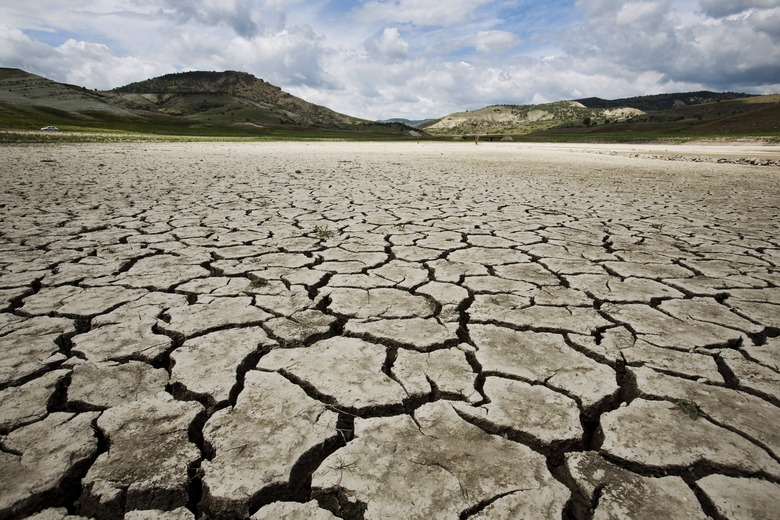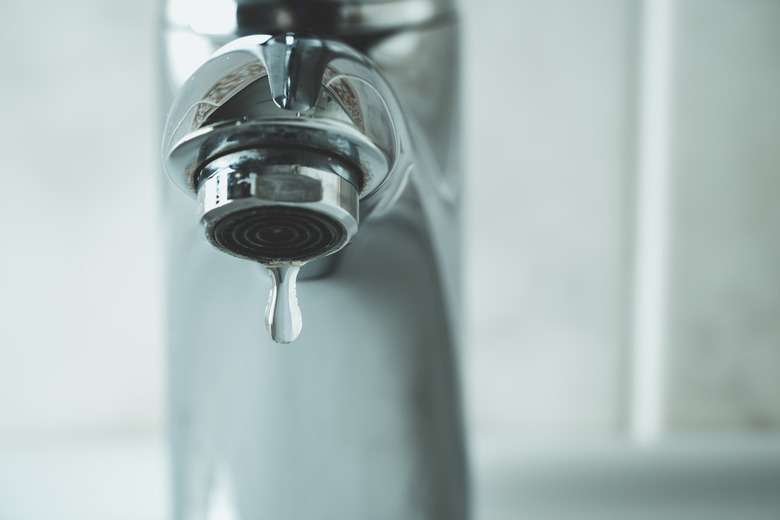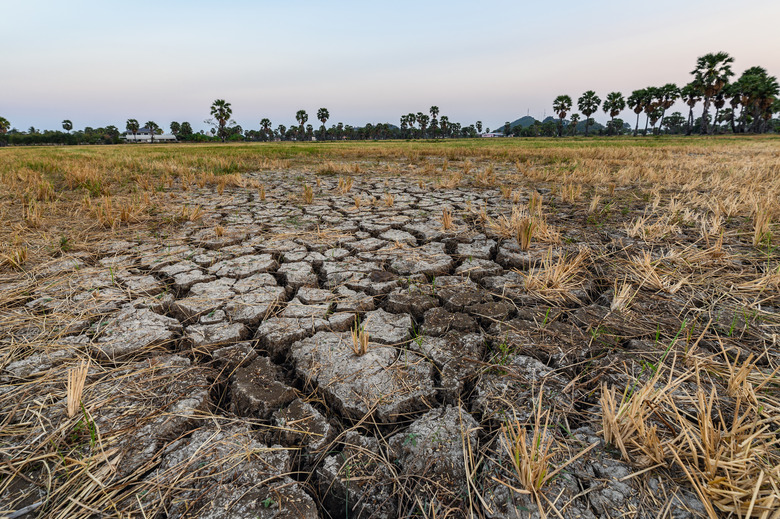Drought Safety: How To Deal And How To Prepare
We may receive a commission on purchases made from links.
Everyone knows that drought safety is an issue for residents of the American Southwest as far north as the interior of Washington and as far east as Louisiana's border with Texas, but these aren't the only United States regions where people have to deal with drought conditions. Surprisingly, states bordering the Great Lakes, including Wisconsin, Illinois, Indiana, Michigan, Ohio, Pennsylvania and New York, experienced abnormally dry conditions in 2021, and a moderate drought band extended through lower Michigan and around the southern border of Lake Erie.
Because of the availability of fresh water, water conservation isn't as critical an issue for people in the Great Lakes region as it is for those in the Southwest, but it could well become so in the future. In a warming world, a number of mechanisms, including enhanced evaporation and a positive feedback loop where dry soil suppresses rainfall, threatens to make droughts longer-lasting and more severe in an increasing number of places.
Water is a necessity for all living things, and when one area runs dry, supplies have to be brought in from elsewhere, so everyone has a stake in water conservation. Perhaps scientists will develop technologies to make it rain in drought-stricken regions someday, but until that happens, drought safety will remain a top-priority issue for the millions of people in the U.S. and around the world in drought zones — and for everyone else as well.
Droughts: A Slow-Moving Natural Disaster
Droughts: A Slow-Moving Natural Disaster
Unlike dramatic events, such as hurricanes, floods and earthquakes, droughts take several years to develop into what can be termed "disasters," and like frogs in the proverbial slowly boiling water, people in a drought zone often don't realize the danger until it's too late. Droughts rank second to hurricanes in the list of disasters associated with weather and end up costing $9 billion dollars per year. Since 1980, states in the most severe drought zones, including Texas, California, Nebraska, Iowa and Illinois, have spent $10 billion to $50 billion on drought remediation.
Drought costs farmers money in the form of reduced production and increased costs for watering and feeding cattle, and these costs get passed on to consumers in the form of higher food prices. These losses can create psychological and emotional problems, such as depression and anxiety, and the unbroken hot, dry weather causes physiological ailments, such as dehydration and heat stroke. A lack of water also damages wildlife habitats and food resources, and it increases the risk of wildfires, which turn serious problems into acute ones when they occur.
In fact, wildfire is one of the chief hazards that result from an extended dry period that develops into a drought. The lack of water dries out vegetation and turns twigs, leaves and other debris into kindling, so wildfire preparedness and drought preparedness go hand in hand. Replacing grass and thirsty plants with drought-tolerant vegetation that can remain green and supple in dry weather not only saves water but helps protect your home by creating a fire-resistant buffer.
Outdoor Drought Safety and Preparedness
Outdoor Drought Safety and Preparedness
Droughts are no more preventable than hurricanes or earthquakes, but people can learn to live with them, and the key is to be ready before the worst hits. Water is a precious resource that nobody should waste, but people in drought zones have to be especially mindful of their water use to avoid depleting the groundwater and hastening the imposition of water restrictions by the local government. If you make the proper preparations, you'll feel less impact during a period of extreme drought than someone who gets caught by surprise by water shortages.
To save water, begin by reducing outdoor water use. According to the Environmental Protection Agency, the average U.S. family uses 320 gallons of water per day, and outdoor watering accounts for 30 percent of that. In arid climates, the proportion can be as high as 50 percent. A good portion of that goes toward watering the lawn, and much of the water distributed by hand watering or by a sprinkler system is lost to evaporation. You can save water by replacing your lawn with native drought-tolerant ground cover, which requires a fraction of the water that grass does, and by incorporating xeriscape techniques into your landscaping plan. Keep some water conservation tips in mind:
- Use mulch to keep water in the soil so you don't have to water as often. Wood chips, straw, cardboard, newspaper and gravel are all good mulching materials. You can also use dead leaves and pine needles that you rake from the yard.
- Irrigate with drip irrigation, which delivers water directly to the roots of the plants, thus minimizing evaporative waste. A drip system is easy to install and uses a fraction of the water that sprinklers use.
- Replace thirsty plants with drought-tolerant ones or with hardscape features, like patios, walkways and rock gardens. A succulent, such as Herniaria glabra, which grows in zones 4 to 8, is a great choice.
- Mow your grass long if you do choose to keep your lawn. Long grass at least 4 inches high retains more water, so you don't have to water as often. Don't let your grass get any longer than this, however, or it could become a fire hazard.
- Make sure the nozzle on your garden hose shuts off reliably and doesn't leak so you won't lose any water if you forget to turn off the faucet.
Don't forget to monitor your outdoor water supply system regularly to make sure you aren't losing water to leaks and be sure to turn off the water and drain your system before winter so that freezing water doesn't burst any pipes. You can also reduce the amount of water the system distributes by using electronic timers and controllers and collecting rainwater through a drainage system so you can use it for irrigation.
Indoor Water Conservation Tips
Indoor Water Conservation Tips
The bulk of the water people consume daily is used indoors, and there are several ways to reduce usage and improve conservation:
- Replace your older toilets. All toilets available today are low-flow models that use a fraction of the water that ones manufactured before 1992 use. They are inexpensive, and installation is easy. If you live in a drought-prone community, there's no excuse for hanging on to your old "water waster." Even if you have low-flow toilets that were installed 10 to 20 years ago, you can save up to 3,800 gallons of water per year by upgrading to models bearing the WaterSense label.
- Install low-flow aerators on all faucets and flow restrictors on your showerheads. If you don't like the idea of getting a sprinkle of water in the shower instead of a more generous and soothing flow, keep your showerhead the way it is but shorten your showers and turn off the water while you're lathering up. Keep a bucket in the shower to catch water that would otherwise go down the drain and use it to irrigate the garden or flush the toilet.
- Stop those leaks. Dripping faucets can waste up to 5 gallons of water per day, and leaking toilets can waste 200 gallons per day. You can often stop a faucet from dripping by simply replacing its cartridge or washers, and all it usually takes to stop a toilet from leaking is either a float adjustment or a new flapper or canister seal.
- Reduce the amount of water you use in the kitchen by putting food waste into a compost pile rather than flushing it into the garbage disposal. Consider installing an on-demand water heater to boost the hot water supply at the kitchen sink so you don't have to wait for the water to travel through the pipe from the water heater. This can save a gallon of water every time you use the sink.
After you put these water-saving measures in place, you can do even more by developing water-wise personal habits. Taking shorter showers is one, and not letting the water run while you're brushing your teeth is another. If you're in the process of remodeling, consider installing a greywater reclamation system so you can use drainage water for irrigation.
Safety During a Drought
Safety During a Drought
When your local government issues a drought advisory, it will issue water-use restrictions, and it's important to follow them for your own safety as well as that of the community. However, even though there's a water shortage, you need more drinking water during a drought than you do at other times because the humidity is low, the temperature is high and your body loses more moisture through evaporation. To prevent dehydration and heat stroke, you should actually increase — not decrease — your water intake, so you have to focus your water conservation efforts elsewhere, and there are a number of ways to do this:
- Reduce the amount of water you give your lawn and garden. If you're in the habit of watering the lawn daily or every other day, water every third day instead and water only plants that really need it.
- Do your outdoor cleanup with a broom or blower, not a garden hose. If you need to use water for cleaning, use a pressure washer instead of a garden hose. It uses less water and does the job more effectively.
- Do the watering in the early morning or evening so water has a chance to sink into the soil before the sun bakes it off. In extreme drought conditions, confine your watering efforts to plants and trees and let the lawn die. This will give you a chance to replant it with something that uses less water, such as drought-tolerant ground cover.
- Wash dishes in the dishwasher rather than in the sink. A dishwasher uses less water and does a better job but don't run it until you have a full load. The same goes for the washing machine
—
full loads only.
- Wash your car at a commercial car wash that uses recycled water. If you have to do it at home, use a bucket of water for washing and hose with a nozzle on the mist setting for rinsing.
- Flush the toilet only when absolutely necessary. If that idea sounds unappealing, consider using reclaimed water from the shower to flush. Flushing after every use is a hard habit to break, so you might want to consider placing a sign on the toilet to remind yourself and other members of your household.
- Take shorter showers and take baths only if you have a plan for recycling the water.
- If you let the kitchen faucet run to get cold water, collect the water rather than letting it run down the drain and put it in the refrigerator to give you a ready supply of cold water for next time. You can also use it to water plants. If it's hot water you're after, consider heating cold water in the microwave.
References
- Center for Climate and Energy Solutions: Drought and Climate Change
- Ready.gov: Drought
- Drought.gov: The Impacts of Drought in the U.S.
- United States Environmental Protection Agency WaterSense: Outdoor Water Use in the United States
- The National Drought Mitigation Center: United States Drought Monitor
- United States Environmental Protection Agency WaterSense: Start Saving


